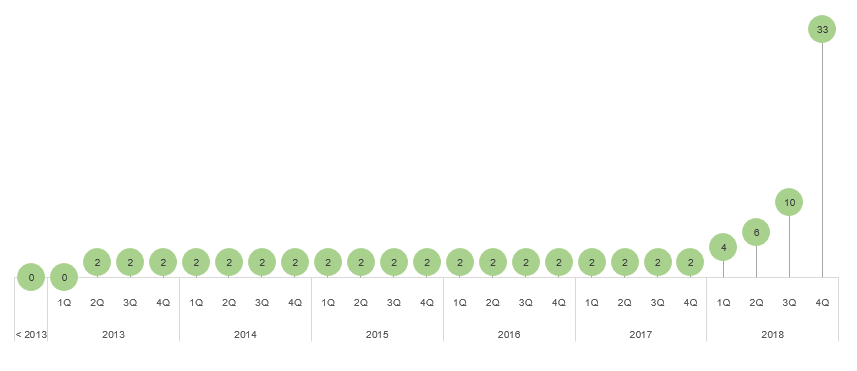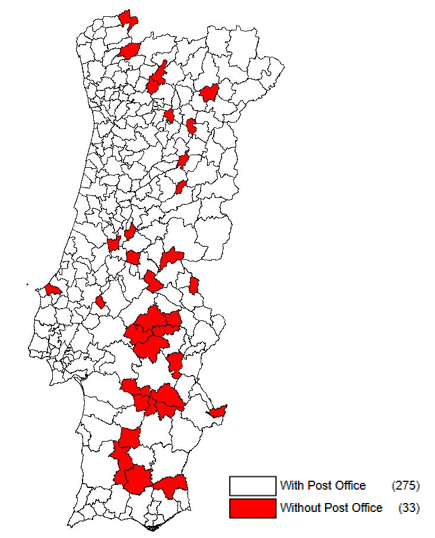In 2018, the closure of post offices by CTT - Correios de Portugal resulted in 33 municipalities in Portugal no longer having post offices. Until 2017, and since 2013, there were only two municipalities without post offices, and there was nothing to indicate that the number of municipalities without post offices would increase exponentially, as happened (see Figure 1). However, according to information received from CTT last November, it is expected that the number of municipalities without post offices will increase to 48 in the near term, which means that 15.6% of all municipalities with over 411 thousand inhabitants will be without a post office.
Figure 1. Quarterly trend in the number of municipalities without post offices

This trend has drastically affected user choice in a particular municipality, for both citizens and businesses, when it comes to opting between a post office or postal services office to meet their postal service needs. If users in affected municipalities, which are overwhelmingly located in the interior of the country (see Figure 2), can only use postal services made available at postal services offices, this must not, under any circumstances, result in a degradation in the the provision of the universal service insofar as satisfaction of the needs of users is compromised. Provision of the universal service must continue to ensure adequate quality standards, in particular as regards delivery times, density of access points, and regularity and reliability of the service, under conditions of equality and non-discrimination.
Figure 2. Municipalities without post offices at the end of 2018

Source: ANACOM, based on data from CTT.
The impact of this situation on affected populations and companies explains the surge in complains and queries arising from this situation and originating from local authorities, inter-municipal communities, the legislative assemblies of the Portuguese Autonomous Regions, representatives of CTT staff and from all parties and parliamentary groups in Assembleia da República (Assembly of the Republic).
On the other hand, the observed development justified ANACOM's performance of a series of inspections focused on postal agencies, especially in municipalities where post offices no longer exist, in order to assess the conditions under which postal services are provided. As a result, it was possible to observe important differences in the way that postal services are provided at postal agencies and at post offices.
CTT itself recognises differences in the provision of postal services at postal agencies and post offices, as demonstrated by the dual certification system implemented by the company using an external entity1. According to data provided by CTT, referring to the end of 2017, although all post offices in operation were certified, only 204 postal agencies were certified (11% of the total). Furthermore, the technical specification applicable to postal agencies is less demanding, in terms of requirements, than the specification applicable to post offices. It should also be noted that the vast majority of certified postal agencies are located on the coast: the ratio of certified postal agencies/total postal agencies in the interior of the country (where only 5.3% of postal agencies are certified) significantly lags the ratio in coastal areas, where 16.2% of postal agencies are certified (see Figure 3).
Figure 3. Postal agencies with customer service certification at the end of 2017
Source: ANACOM, based on data from CTT.
After concluding that there is a set of exceptional circumstances that justify urgent review of the objectives of postal network density and minimum offers of service, ANACOM decided to intervene pursuant to the responsibilities and powers conferred by the law and the Concession Contract.
CTT, as concessionaire of the universal postal service, is required to comply with a set of obligations established by law and under the concession contract, including, first and foremost, the obligation to provide the universal postal service throughout the national territory, ensuring availability and quality through a set of access points whose density responds and matches the needs of users.
The concession bases establish the general obligations of the concessionaire: (i) to ensure the secrecy and inviolability of postal items, as well as protection of data and protection of privacy in all postal services provided; (ii) to ensure equality and transparency in access to and use of services under equal conditions; and (iii) to adopt measures ensuring ease of use for users with special needs, specifically by adapting the structures where this service is provided to ensure ease of access.
The concession bases and provisions of the concession contract allow and authorise the subcontracting of third parties to perform works and/or provide services that constitute or are related to the concessionaire's contractually assumed obligations. Nevertheless, it is expressly established that, where third parties intervene in the activities of the concession, CTT, as concessionaire, retains the rights and remains, directly and personally, subject to the obligations arising from the concession bases and under the contract.
The intervention of third parties in the concession may not, under any circumstances, compromise provision of concession services, in compliance with the requirements of quality, equality and non-discrimination imposed by Law.
Accordingly, while CTT remains responsible, as concessionaire, for deciding which type of postal establishment is used to ensure provision of postal services to the population, and is also responsible for deciding on the opening and closure of postal establishments, as well as on changes to their operating hours (in compliance with the requirements of the objectives of postal network density and minimum offers of service), it is clear that the options taken by the concessionaire cannot, under any circumstance, result in a deterioration in the quality of such services and in the conditions of their provision.
Considering the applicable framework, ANACOM has adopted a decision in which it orders CTT to present a proposal, within 20 working days, that complements the objectives that are in force, based on the following (i) at least one post office in each municipality or a postal services office with characteristics equivalent to those of a post office, and (ii) that the postal services office must adhere to the following factors, in order to satisfy user needs in terms of access to postal services:
a) the training of staff at postal services offices who serve customers of postal services;
b) the guarantee of ease of access by users in general and by users with special needs;
c) clear identification of customer service areas and the provision of information which is relevant to the public regarding the postal services provided;
d) the establishment of customer service procedures that minimise waiting times;
e) the adoption of procedures that contribute to guaranteeing the confidentiality, secrecy and inviolability of postal items and protection of privacy;
f) regular compliance with established operating hours;
g) establishment of procedures to assess user satisfaction and enable corrective action to be taken, as appropriate, and to enable appropriate handling of complaints;
h) the establishment of a procedure for recording non-conformities;
i) maintenance and operation of infrastructure and equipment contributing to the provision of a quality service.
The reference framework to be observed by CTT in its proposal is submitted to public consultation, for a period of 20 working days.
ANACOM recommends to CTT that during the procedure of reviewing the objectives of postal network density and minimum offers of service, it refrain from taking any measures which contradict the objectives set out in this determination.
ANACOM also orders CTT that, in cases where postal establishments are closed (post offices or postal agencies) or where operating times are reduced, that they inform users and ANACOM at least 20 working days in advance.
In case of closure, the information must be given by means of a notice displayed prominently at the entrance to the establishment, specifying the postal establishment's last day of operation, details of the two nearest postal establishments providing at least the concession services that are guaranteed in the postal establishment subject to closure, their respective addresses and timetable of operation.
In cases where there is a reduction in operating hours, the notice must provide details of the new operating hours and the date from which they will come into effect.
This obligation to give prior notice is submitted to a prior hearing of CTT for a period of 20 working days.
ANACOM also makes a series of recommendations to CTT:
- that the requirements defined by ANACOM for the remaining postal agencies be implemented in a progressive and scheduled manner, starting with offices located in parishes which have more than 10 thousand inhabitants but no post offices;
- that, when they intend to close establishments or reduce operating hours, they notify local authorities where the establishment is located at least 20 days prior to the date on which the change takes effect;
- that, if CTT intends to close all post offices in a given municipality, so that the municipality is served only by postal agencies, this solution must be subject to previous agreement with local authorities, seeking adoption of a solution which ensures adequate satisfaction of the needs of local populations and businesses.
This public consultation on the reference framework is conducted for a period of 20 working days, closing on 7 February 2019. Contributions should be sent to estacoes-e-postos-de-correios@anacom.pt. ANACOM appeals for broad intervention by the various agents and market participants concerned.
1 CTT have been certifying customer service activities in post offices and postal agencies as part of a strategy that ''aims to contribute significantly to the consistency and quality of services provided, optimise processes in the various phases of the value chain, develop and foster staff participation and improve customer satisfaction while enhancing CTT's image''.
Consult:
- Review of objectives of postal network density and minimum offers of service https://www.anacom.pt/render.jsp?contentId=1466756
- Consultation on the review of objectives of postal network density and minimum offers of service https://www.anacom.pt/render.jsp?contentId=1466757




